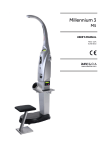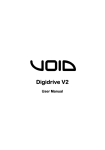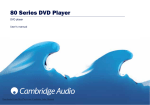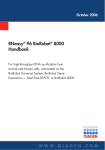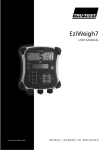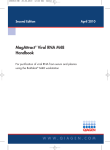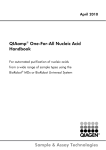Download Evaluating pipetting accuracy of the BioRobot EZ1 workstation using
Transcript
QIAGEN Supplementary Protocol: Evaluating pipetting accuracy of the BioRobot® EZ1 workstation using the EZ1 Test Card This protocol is designed to evaluate the pipetting accuracy of the BioRobot EZ1 workstation. The BioRobot EZ1 pipets either 100 µl or 500 µl of water from one set of tubes to another. Pipetting accuracy should be within defined specifications of ±8 µl for 100 µl, corresponding to pipetted volumes in the range of 92–108 µl and ±40 µl for 500 µl, corresponding to pipetted volumes in the range of 460–540 µl. The protocol also describes how to test the tip adapters for liquid leaks. IMPORTANT: Please read the BioRobot EZ1 User Manual, paying careful attention to the safety information, before beginning this procedure. Equipment and reagents to be supplied by user EZ1 Test Card (cat. no. 9016187) 6 Sarstedt microcentrifuge tubes (1.5 ml) with caps (e.g., tubes and caps supplied with EZ1 Kits) 6 Sarstedt microcentrifuge tubes (2 ml) without caps (e.g., tubes supplied with EZ1 Kits) Calibrated laboratory balance, with precision of 0.0005 g (0.5 mg) Deionized water Disposable gloves Important points before starting The BioRobot EZ1 should be positioned on a level workbench Ambient temperature should be in the range of 15–32°C Procedure Volume validation 1. 2. 3. 4. 5. Label and weigh 6 microcentrifuge tubes (1.5 ml) together with the corresponding caps. Record the weight for each set of tube and cap. Insert the EZ1 Test Card completely into the EZ1 Card slot of the BioRobot EZ1. Switch on the BioRobot EZ1. The power switch is located on the left rear of the instrument. Press “START” to display the protocols menu. Press “1” for the 100 µl Protocol or “2” for the 500 µl Protocol. WWW.QIAGEN.COM 6. Press any key to proceed through the text displayed in the LCD and start worktable setup. The text summarizes the following steps which describe the loading of the worktable. Wear gloves when loading the required items on the worktable. 7. Remove the caps from the labeled, weighed 1.5 ml tubes, and load the opened tubes into the first row. 8. Fill the 6 unweighed 2 ml tubes (without caps) with approximately 1 ml water. Load the filled, opened tubes into the fourth row (back row). 9. Load 6 tip holders containing filter-tips into the second row. 10. Close the workstation door. 11. Press “START” to start the protocol. The automated procedure takes 2 min. 12. When the protocol ends, the LCD displays “Protocol finished”. Open the workstation door. 13. Press “ESC” to return to the main menu. 14. Remove the labeled tubes from the first row (front row), and cap them securely with the corresponding weighed caps. 15. Weigh the closed tubes and record the weights. The weights can be recorded in the test report on page 5 together with the results of the temperature accuracy test (see QIAGEN Supplementary Protocol MA32: Evaluating temperature accuracy of the BioRobot EZ1 workstation). 16. Calculate the difference in weight of each tube by subtracting the weight of the empty tube and cap, recorded in step 1. 17. Calculate the accuracy of pipetting. If the difference in weight is in the range of 92–108 mg for the “100 µl Protocol” or 460–540 mg for the “500 µl Protocol”, then the accuracy is within the defined specifications. If the accuracy is not within the defined specifications, contact QIAGEN Instrument Service to recalibrate the instrument. 1 mg = 1 µl water. The weight range of 92–108 mg corresponds to 92–108 µl water and the weight range of 460–540 mg to 460–540 µl. The table on the next page gives an example. Evaluating pipetting accuracy of the BioRobot EZ1 workstation (MA31 Jan-06) page 2 of 7 Example of Weight-Measure Results and Calculation of Pipetted Volume* Tube Weight before run (g) Weight after run (g) Difference (g) Pipetted volume (µl) 1 1.4004 1.9049 0.5045 504.5 2 1.4028 1.9044 0.5016 501.6 3 1.3934 1.8989 0.5055 505.5 4 1.4018 1.9053 0.5035 503.5 5 1.4078 1.9127 0.5049 504.9 6 1.4060 1.9005 0.4945 494.5 * Example only. Actual results may differ from those shown. 18. To run another pipetting accuracy protocol, carry out step 1 of the protocol, and then follow the protocol from step 4. Otherwise close the workstation door, and switch off the BioRobot EZ1. Save the 1.5 ml and 2 ml tubes for use in the leakage test. Steps 2 and 3 are not necessary when running another protocol. Skip these steps. 19. Clean the BioRobot EZ1. Follow the maintenance instructions in the BioRobot EZ1 User Manual. Leakage test 1. 2. Insert the EZ1 Test Card completely into the EZ1 Card slot of the BioRobot EZ1. Switch on the BioRobot EZ1. The power switch is located on the left rear of the instrument. 3. Press “START” to display the protocols menu. 4. 5. Press “3” to choose the leakage test. Press any key to proceed through the text displayed in the LCD and start worktable setup. The text summarizes the following steps which describe the loading of the worktable. Wear gloves when loading the required items on the worktable. 6. 7. Load 6 opened 1.5 ml tubes into the first row (front row). Fill six 2 ml tubes (without caps) with approximately 1 ml water. Load the filled, opened tubes into the fourth row (back row). Load 6 tip holders containing filter-tips into the second row. Close the workstation door. 8. 9. 10. Press “START” to start the protocol. The automated procedure takes 12 min. The instrument will wait for 10 min to check the tightness around the O-rings. Evaluating pipetting accuracy of the BioRobot EZ1 workstation (MA31 Jan-06) page 3 of 7 11. When the protocol ends, the LCD displays “Protocol finished”. Open the workstation door. 12. Check that there has been no dripping from the tips during the test. The results of the test can be recorded in the test report on page 5. 13. Close the workstation door before pressing “ESC” to return to the main menu. 14. To run another leakage test, follow the protocol from step 4. Otherwise close the workstation door, and switch off the BioRobot EZ1. Steps 1, 2, and 3 are not necessary when running another protocol. Skip these steps. 15. Clean the BioRobot EZ1. Follow the maintenance instructions in the BioRobot EZ1 User Manual. Evaluating pipetting accuracy of the BioRobot EZ1 workstation (MA31 Jan-06) page 4 of 7 Test report for pipetting accuracy and temperature accuracy of the BioRobot EZ1 workstation The results of the volume validation and leakage test and also the temperature accuracy test (see QIAGEN Supplementary Protocol MA32: Evaluating temperature accuracy of the BioRobot EZ1 workstation) can be recorded here by the user for the operational qualification of the BioRobot EZ1. Instrument and operator Instrument: BioRobot EZ1 Serial number: __________________________________________ Location: __________________________________________ Test operator: __________________________________________ Test date: __________________________________________ Volume validation Pipetting 100 µl of water Specification: Pipetted volumes must be between 92 µl and 108 µl. Tube Weight before run (g) Weight after run (g) Difference (g) Pipetted volume Passed (µl) Failed 1 2 3 4 5 6 Evaluating pipetting accuracy of the BioRobot EZ1 workstation (MA31 Jan-06) page 5 of 7 Pipetting 500 µl of water Specification: Pipetted volumes must be between 460 µl and 540 µl. Tube Weight before run (g) Weight after run (g) Difference (g) Pipetted volume Passed (µl) Failed 1 2 3 4 5 6 Leakage test Specification: There must be no dripping from the tips during the test. Tube Tips dripped during the run Passed Failed 1 2 3 4 5 6 Temperature accuracy test (see QIAGEN Supplementary Protocol MA32: Evaluating temperature accuracy of the BioRobot EZ1 workstation) Specification: Measured temperatures must be in the range of 57–63°C. Measured temperature (°C) Evaluating pipetting accuracy of the BioRobot EZ1 workstation (MA31 Jan-06) Passed Failed page 6 of 7 Equipment used Laboratory Balance Brand: _______________________________________ Model: _______________________________________ Range: _______________________________________ Accuracy: _______________________________________ Serial no.: _______________________________________ Last calibration date: _______________________________________ Thermometer Brand: _______________________________________ Model: _______________________________________ Range: _______________________________________ Accuracy: _______________________________________ Serial No: _______________________________________ Last calibration date: _______________________________________ Signature: ___________________________ Date: ___________________________ The BioRobot EZ1 workstation and the EZ1 Test Card are intended as general-purpose devices. No claim or representation is intended for their use to identify any specific organism or for a specific clinical use (diagnostic, prognostic, therapeutic, or blood banking). It is the user’s responsibility to validate the performance of the BioRobot EZ1 workstation and the EZ1 Test Card for any particular use, since their performance characteristics have not been validated for any specific organism. The BioRobot EZ1 workstation and the EZ1 Test Card may be used in clinical diagnostic laboratory systems after the laboratory has validated their complete system as required by CLIA '88 regulations in the U.S. or equivalents in other countries. QIAGEN handbooks can be requested from QIAGEN Technical Service or your local QIAGEN distributor. Selected handbooks can be downloaded from www.qiagen.com/literature/handbooks/default.aspx . Material safety data sheets (MSDS) for any QIAGEN product can be downloaded from www.qiagen.com/ts/msds.asp . Trademarks: QIAGEN®, BioRobot® (QIAGEN Group). © 2005–2006 QIAGEN, all rights reserved. Evaluating pipetting accuracy of the BioRobot EZ1 workstation (MA31 Jan-06) page 7 of 7







